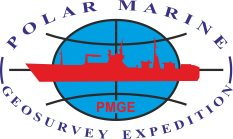Protocol on Environmental Protection to the Antarctic Treaty, that came into force in 1999, imposes a 50-year moratorium on works directly related to prospecting, exploration and extraction of minerals, but does not prohibit scientific geological and geophysical research. Such studies are intensively carried out by many states (parties to the Antarctic Treaty).
Despite the reduction of public funding for
work in the Antarctic in recent years, so far it is possible to defend the
international authority of Russia in the geological community for the study of
the region. Preservation of the positions won during a half-century history of
the native geological and geophysical studies of Antarctica carried out by
organizations of Ministry of Natural Resources of Russian Federation (formerly
Ministry of Geology of USSR), is largely due to the wealth of experience of
these organizations and well-functioning organizational and economic relations
between them. All research in the Antarctic is carried out as part of the
Russian Antarctic Expedition, under the flag of which all national activities
are carried out in the Antarctic Treaty area. According to the nature of the
work carried out, two main directions of geological and geophysical research
developed: continental works and marine research in the ocean areas adjacent to
Antarctica.
Marine geological and geophysical studies in
the marginal seas of Antarctica hold important place in the study of the ice
continent structure. For the first time systematic geological and geophysical
work in Antarctica was carried out by the Antarctic Geophysical Party of PMGE as
a part of SAE (Soviet Antarctic Expedition) in 1980-1981 (CDP and onboard
gravimetric survey), and since then they’ve been held almost annually to the
present time (with the exception of the 38th Soviet and 42nd Russian Antarctic
Expeditions).
Further, starting with the 27th RAE
(1982-1983), the main types of work have been and continue to be investigations
by the method of the common depth point of reflected waves (CDP), seismic
sounding (refracted wave method), gravimetric, hydromagnetic and geological
sampling of bottom sediments in combination with seismoacoustic profiling up to
33 SAE inclusive. These methods allow solving geological problems aimed at
studying the deep structure of the earth crust of the Antarctica continental
margin, identifying and studying the sedimentary basins in the
region-reconnaissance plan and their structure. Based on the results of the work
done, it is possible to draw conclusions about the prospects of a particular
region of Antarctica continental margin for minerals.
During the work the vessels and operation
technique changed. Works from the 26th to the 36th SAEs were carried out from
leased diesel-electric vessels ("Captain Markov", "Vasily Fedoseev", "Captain
Myshevsky", "Captain Gotsky", " Vitus Bering "," Vladimir Arsenyev "," Navarin
"). Vessels were changed every year, equipment for work was placed in marine
20-foot containers and was transferred from one vessel to another.
From
the 37th RAE (Russian Antarctic Expedition), the PMGRE scientific research
vessel "Academik Alexander Karpinsky" was sent to carry out marine work in the
Antarctic after reequipment (Fig. 1).
Fig. 1. R/V "Academik Alexander Karpinsky"
During the work in Antarctica the technical
equipment of the R / V "Academik Alexander Karpinsky" was changing. R/V was
permanently equipped with seismic hydroacustic complex HAC-120, MTS, gravity
complex Cheta AГГ, differential towed magnetometer MBM-1. The on-board computer
center was equipped with two integrated system computers EC-1011.
In 2002, the seismic complex was re-equipped.
The vessel was equipped with: - MSX-6000 marine recording system, a seismic
streamer with a receiving base of 6000 m MSX-6000, two lines of SG-IIB pneumatic
sources with a volume of 2860 dm3 produced by INPUT / OUTPUT Inc. (USA), the
rear part of the R/V was reconstructed with the installation of hydraulic
lifting and lowering equipment of the Norwegian company "ODIM" to accommodate
the seismic streamer and two lines of pneumatic sources.
In 2014, a comprehensive reconstruction of the R / V "Academik Alexander Karpinsky" was carried out under a state contract (a source of financing - budgetary investments). During the reconstruction work was carried out on the modernization of ship equipment and mechanisms. In accordance with modern standards and requirements for living conditions of the crew and scientific staff during long-term autonomous navigation, a part of the residential and office (laboratory) premises of the vessel was reconstructed, as well as the reconstruction of the food storage chambers.
Fig.2. Digital Seismic Recording System DigiSTREAMER
During the reconstruction at the R / V
"Akademik Alexander Karpinsky", a new integrated system for collecting marine
seismic data DigiSTREAMER ™ 2D, consisting of a DigiSTREAMER recording complex
complete with DigiSREAMER towed seismic streamer, allowing seismic studies in
complex marine conditions, was installed. The onboard equipment is intended for
seismic streamer control, and recording of seismic data; it allows to conduct
on-line quality control of the received material. Outboard equipment is a
seismic solid state (with gel filling) streamer with built-in hydrophones
(groups of hydrophones) for recording seismic signals, towed behind the stern of
the ship, the maximum length is 8000 km (640 channels).
Fig. 3. Seismic streamer DigiSREAMER 8000 m
Also, equipment was purchased to enable the
seismic complex to significantly improve the positioning accuracy of the vessel
and the outboard equipment, and improve the quality of the data: a system for
monitoring, testing and controlling the deepening devices PCS SYSTEM 3 and a set
of seismic digging devices (such as DigiBird 5010 and DigiBird 5011E), allowing
to control the position of the streamer in depth; a system for positioning the
2D seismic streamer tail buoy (Seatex Seatrack 220 satellite receiver);
navigation complex ORCA 2D, designed to control the seismic work and collection
of the navigational data and data on position of the outboard equipment during
2D seismic survey (a software license can be purchased on a lease basis for a
period of work).
To ensure the operation of the SG-IIB
pneumatic sources of the seismic complex, new high-pressure compressors SAUER WP
6442 are installed.
DigiSREAMER seismic streamer.
The outboard part of the differential
sea magnetometer SeaSpy 2
On-board gravimetric complex
consisting of two gravimeters "Chekan AM"
Fig. 4. The outboard part of the differential marine
magnetometer SeaSpy-2 and Fig. 5. The on-board gravimetric complex, consisting
of two gravimeters "Chekan AM"
To
extend the methodological possibilities of using R/V during geological and
geophysical studies, the following equipment is additionally installed: -
navigation and bathymetric complex (multi-beam sounder) ATLAS HYDROSWEEP MD / 30
1.5 ° х1.5 ° (with a set of high-precision detection and recording of the
course, roll, pitch and heave displacement Teledyne TSS MAHRS) and a set of
bottom geological sampling equipment.
Fig.6. ATLAS HYDROSWEEP MD / 30 multi-beam sounder operator station
Fig.7. Winch for bottom geological sampling
Also, new software (ProMAX 2D (ProMAX /
SeisSpace 2D), LMKR GeoGraphix, Geosoft Oasis montaj) was installed within the
reconstruction program to process seismic and gravimagnetic data, and the
computer hardware of the on-board computer center was updated.
The implementation of the reconstruction
program made it possible to create on the basis of the R/V "Akademik Alexander
Karpinsky" a modern multipurpose geological and geophysical vessel capable of
providing a high level of seismic work using the methods of CDP, RWM, WDSP,
gravimagnetic and geological studies of continental margins in the Arctic and
Antarctic, and to extend the period of effective ship operation. The
reconstruction carried out significantly increased the geological and
geophysical information content of research and safety of offshore operations
and ensured compliance with the requirements of the Protocol on Environmental
Protection to the Antarctic Treaty of 1959.
Over the past years, the geological structure
of sedimentary basins of the Indian Ocean area of the Antarctic has been studied
by the regional reconnaissance network of profiles: - the Lazarev Sea, the
Cooperation Sea, the Riiser-Larsen Sea, the Cosmonauts Sea, the Davis Sea and
the d'Urville Sea.
The Indian Ocean area of the Antarctic
includes the shelf, the continental slope, the foot of the continental slope,
the abyssal basins and the southern part of Kerguelen Plateau (Figure 0.1). Some
sectors of this area were named marginal seas. These include: the Riieser-Lersen
Sea (14 ° -34 ° E), the Cosmonauts Sea (34 ° -54 ° E), the Cooperation Sea (54 °
-82 ° E), the Davis Sea (87 ° -97 ° E), the Mawson Sea (96 ° -113 ° E), the
d'Urville Sea (136 ° -148 ° E, Atlas of the Antarctic, 1966).
Fig.8. The studied sector of the continental margin of
Antarctica
The Indian Ocean is the most studied part of the Southern Ocean. Here, under the supervision of PMGE and with the participation of VNIIOkeangeologia specialists, the reconnaissance stage of the works was completed by the PMGE. Own set of geophysical (primarily seismic) materials allows a detailed description of the sedimentary basins of this region. The length of the studied water area in latitude is about 6,500 km, and its total area exceeds 4.5 million km2.
Fig. 9. Network of regional reconnaissance profiles
performed by JSC "PMGE" in the Indian Ocean area of Antarctica
The Indian continental margin of Antarctica and adjacent basins were formed as a result of rifting, oceanic spreading and subsequent submersion of the Earth crust during the late Mesozoic and Cenozoic. These processes led to the formation of large sedimentary basins with a thickness of sedimentary cover up to 7-8 km, which, according to preliminary estimates, have high oil and gas prospects.
Fig. 10. Sedimentary basins of the Indian Ocean continental
margin of Antarctica
In the studied sector of the Antarctic, three large sedimentary basins can be distinguished; each of them has specific features of development (especially in the rift and early post-rift stages): the Riiser-Larsen Sea basin, the Cosmonauts Sea, Cooperation Sea, Davis Sea basin, and the basin located in the sector from the Mawson Sea to the d'Urville Sea (hereinafter referred to as the Mawson-d'Urville Sea Basin). The basins include continental margins and southern parts of their oceanic hollows.
Complex interpretation of geophysical data
obtained in the Indian Ocean area of the Antarctic allows one to approach many
fundamental problems of the evolution of passive continental margins, the
development of oceans and volcanic plateaus. Such problems include: the dynamics
of extreme stretching of the Earth crust and the penetration (opening) of the
continental mantle; identification of the continent-ocean boundary, stability of
seabed spreading in conditions of ultra-slow oceanic opening, character and
volume of magmatism of non-volcanic margins; nature of the volcanic plateau
crust; mechanisms for the invasion of asthenospheric plumes (hot jets)
Fig. 11. The section of the earth's crust on the
continental margin of Antarctica (the Cooperation sea).
In the short term, marine geological and geophysical research is planned to be carried out within the framework of the State program in the Pacific sector of the western Antarctic.





